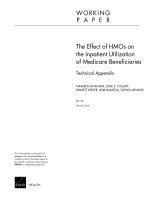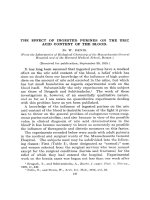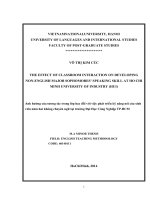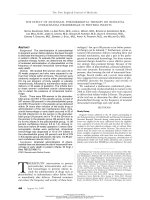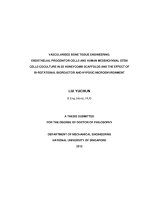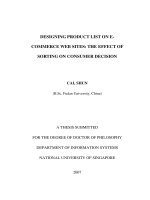ENHANCING RESIN DENTIN BOND DURABILITY THE EFFECT OF CHITOSAN RIBOFLAVIN MODIFICATION
Bạn đang xem bản rút gọn của tài liệu. Xem và tải ngay bản đầy đủ của tài liệu tại đây (1.74 MB, 191 trang )
Enhancing Resin/Dentin bond durability: The Effect
of Chitosan/Riboflavin Modification
By
Umer Daood
Thesis Submitted
In Partial Fulfillment of the Requirements
For the Degree of
MASTER OF SCIENCE (RSH-FoD)
At
Discipline of Oral Sciences, Faculty of Dentistry
National University of Singapore
2013
Supervisors: Assistant Professor Amr Fawzy (Main supervisor)
Associate Professor Cao Tong
!
"!
(Co- supervisor)
Declaration
I hereby declare that the thesis is my original work and it has
been written by me in its entirety. I have duly
acknowledged all the sources of information which have
been used in the thesis.
This thesis has also not been submitted for any degree in any
University previously.
_________________
Dr Umer Daood
20th November 2013
!
#!
Acknowledgement
My deepest appreciation to Almighty Allah for letting me through this
academic journey. I would like to thank my supervisor and the scientific committee
members on providing me full support for my work here at Faculty of Dentistry,
National University of Singapore. My special thanks to Dr Amr Fawzy for his
thoughtful and patient guidance throughout the course. I would also acknowledge my
co-supervisor Associate Professor Cao Tong who had also helped me get through
with this academic task. I am indebted for all the efforts that they have put in and
helping me achieve this milestone. I would also want to thank Dr. Sudhiranjan
Tripathy and Mr. Surani Dolmanan at Institute of Materials Research Engineering
(IMRE, Singapore) for their technical assistance in micro-Raman analysis of the
specimens.
My special acknowledgements to my wife, son and family whose support had
helped me throughout the entire course. Finally I would like to thank the members of
the lab and the friends in NUS who took me from strength to strength.
!
$!
Table of Contents
Acknowledgement -------------------------------------------------------------------
2
Table of Contents --------------------------------------------------------------------
3
!"#$%&'%(")*+,#!-----------------------------------------------------------------------
6
List of Tables ------------------------------------------------------------------------
42
List of Abbreviations ---------------------------------------------------------------
48
List of Deliverables ------------------------------------------------------------------
50
Abstract -------------------------------------------------------------------------------
51
1.
Introduction to Dentin Structure -------------------------------------------
54
1.1. Intertubular dentin --------------------------------------------------------------
55
1.2. Peritubular dentin ---------------------------------------------------------------
57
1.3. Tertiary dentin -------------------------------------------------------------------
58
2.
Riboflavin – Chemistry and Biological function -------------------------
59
3.
Collagen Structure -------------------------------------------------------------
63
3.1. Distribution and Biosynthesis --------------------------------------------------
64
3.2. Functions --------------------------------------------------------------------------
66
3.3. Degradation -----------------------------------------------------------------------
68
3.4. Bonding Hydrolysis --------------------------------------------------------------
69
4. Chitosan Structure --------------------------------------------------------------
70
4.1. pH ----------------------------------------------------------------------------------
71
4.2. Applications ----------------------------------------------------------------------
72
4.3. The Collagen Chitosan Relationship ------------------------------------------
73
5. Singlet Oxygen Radical Theory ----------------------------------------------
75
5.1.Riboflavin singlet oxygen --------------------------------------------------------
77
5.2. Generation of singlet oxygen by light in the presence of
!
%!
Endogenous and exogenous sensitizers ----------------------------------------------
78
5.3. Singlet oxygen and protein breakdown -----------------------------------------
78
6. Collagen Crosslinking -----------------------------------------------------------
80
7. Raman Spectroscopy ------------------------------------------------------------
84
7.1. Raman Mapping and Imaging Instrumentation ------------------------------
84
7.2. Sampling for Raman Spectroscopy; Applications ---------------------------
85
7.3. Protein Spectra -------------------------------------------------------------------
86
7.4. Raman of the Hybrid Layer -----------------------------------------------------
87
7.5. Raman spectroscopy is an effective technique for --------------------------the analysis of monomers and polymers
89
8. Resin bonding to dentin ---------------------------------------------------------
91
8.1. Adhesive systems ----------------------------------------------------------------
94
8.2.Two-Step-etch-and-rinse --------------------------------------------------------
95
8.3. Self-etch adhesive system – a drive for simplification----------------------
97
8.4. Hybrid layer formation and degradation ------------------------------------
98
8.5. Crosslinking and reinforcement of dentin collagen ------------------------
103
9. Hypotheses and Aim!------------------------------------------------------------
107
10. Materials and Methods -------------------------------------------------------
109
10.1. Phase I -------------------------------------------------------------------------
109
10.2. Phase II ------------------------------------------------------------------------
116
10.3. Phase III -----------------------------------------------------------------------
122
11. Results ---------------------------------------------------------------------------
127
11.1. Phase I -------------------------------------------------------------------------
127
11.2. Phase II ------------------------------------------------------------------------
130
11.3. Phase III -----------------------------------------------------------------------
133
!
&!
12. Discussion!-----------------------------------------------------------------------
137
12.1. Introduction -------------------------------------------------------------------
137
12.2. Phase I Discussion -----------------------------------------------------------
142
12.3. Phase II Discussion ----------------------------------------------------------
148
12.4. Phase III Discussion ---------------------------------------------------------
153
13. Summary, conclusions and Future Work ------------------------------
158
14. Bibliography ------------------------------------------------------------------
162
!
'!
List of Figures
Fig 1. SEM of 35% phosphoric acid etched dentin showing open dentinal tubules
lined with peritubular dentin as indicated by arrow (adapted from SEM evaluation of
the interaction pattern between dentin and resin after cavity preparation using
ER:YAG laser; Journal of Dentistry (2003) 31, 127–135).
!
(!
Fig 2. Schematic representation of the peritubular and mineralized intertubular dentin.
!
)!
Fig 3. Tertiary dentin also known as Reactive Dentin is seen clearly in this tooth
model produced as a reaction to the caries.
( />
!
*!
Fig 4. Schematic presentation of the chemical structure of riboflavin indicating the
CH2OH positioning by the transfer of electrons in alloxan, and oxylene.
!
"+!
Fig 5. Type I collagen shown as a molecular structure of fibrillar collagen with
various subdomains with cleavage sites for N- and C-procollagenases (adapted and
redrawn from ‘Collagens—structure, function, and biosynthesis’; Advanced Drug
Delivery Reviews 55 (2003) 1531– 1546)
!
""!
Fig 6. The lysyl mediated mature crosslinks formed within the collagen Type I fiber;
lysyl pyridinoline and hyroxylysyl-pyridinoline.
!
"#!
Fig 7. The collagen triple helix. (a) The crystal structure of collagen molecule; (b)
view down the axis of triple helix with three strands with space filling, ball stick and
ribbon presentation; (c) ball and stick profile of collagen triple helix; (d) stagger for
three strands (Proteins: Three Dimensional Structure; Section 6-1. Secondary
Structure).
!
"$!
Fig 8. The degree of N-acetylation in the physiochemical nature of chitin and chitosan
(adapted from Biomedical Activity of Chitin/Chitosan Based Materials—Influence of
Physicochemical Properties Apart from Molecular Weight and Degree of NAcetylation; Polymers 2011, 3(4), 1875-1901; doi:10.3390/polym3041875 Review).
!
"%!
Fig 9. Patterns of cross-linking collagens. Collagen types I (2), III (4), and IV (6)
show a banding pattern distinct from the other two shown. The riboflavin sensitization
with UVA causes the collagen Type I to almost disappear (3) [Effects of UltravioletA and riboflavin on the Interaction of Collagen and Proteoglycans during Corneal
Cross-linking; Published, JBC Papers in Press, February 18, 2011, DOI
10.1074/jbc.M110.169813; Yuntao Zhang1, Abigail H. Conrad, and Gary W. Conrad.
!
"&!
Fig 10. The Type I mechanism leading to electron transfer as a result of hydrogen
atom abstraction, thus yielding free radicals, which in turn can react with the available
oxygen species to form the superoxide ion. The Type II mechanism results in
collision of the excited sensitizer and the triplet excited oxygen that also results in an
energy transfer. [Reproduced from (1995) Royal Chemical Society].
!
"'!
Fig 11. The allysine crosslinking pathway with lysine residues for intermolecular
crosslinking. The skin collagen involves histidine forming mature crosslinks (Adapted
from Collagen Cross-Links; Top Curr Chem (2005) 247: 207–229).
!
"(!
Fig 12. Hydroxylation of crosslinking lysine residues showing bone tissue specific
crosslinking (Adapted from Collagen Cross-Links; Top Curr Chem (2005) 247: 207–
229).
!
")!
Fig 13. Raman and Rayleigh scattering compared in the Jablonski diagram in which a
molecule getting excited to a virtual state in lower energy with photon losing its
energy in Stokes Raman shift and gains a photon in Anti-Stokes Raman shift.
!
"*!
Fig 14. Raman spectra obtained from procine cartilage explants with minimal 960 cm1
peak [Adapted from Early detection of biomolecular changes in disrupted porcine
cartilage using polarized Raman spectroscopy; J. Biomed. Opt. 2011;16(1):017003017003-10. doi:10.1117/1.3528006].
!
#+!
Fig 15. Schematics (redrawn) showing acid etching of mineralized dentin removing
the smear layer leading to demineralization and exposing the collagen fibrils.
(Redrawn from Pashely DH, Ciucchi B, and Sano H. Dentin as a bonding substrate.
Dtsch Zahn Z 1994;49:760-63)
!
#"!
Fig 16. Scanning electron micrograph of the resin-dentin interface bonded with 3M
Single Bond ESPE (1500x). (a) dental composite; (b) adhesive bond; (c) hybrid layer;
(d) resin tags.
!
##!
Fig 17. Scanning electron microscopic image of the resin-dentin interface bonded
with 3M Single Bond ESPE. A uniform hybrid layer (HL) formation can be seen with
visible resin tag (RT) formation.
!
#$!
Fig 18. Collagenolysis in the presence of collagenase and unwinding of the triple
helix in the alpha chain (Nagase H, Fushimi K. Elucidating the function of noncatalytic domains of collagenases and aggrecanases. Connective Tissue Research.
2008;16:9:74).
!
#%!
Fig 19. Obtained Raman spectrum of the (a) control demineralized specimen; (b)
Adper TM Single Bond; (c) and chitosan in the region of 700-1700 cm-1 (Daood et al;
Effect of chitosan/riboflavin modification on resin/dentin interface: Spectroscopic and
microscopic investigations).
!
#&!

